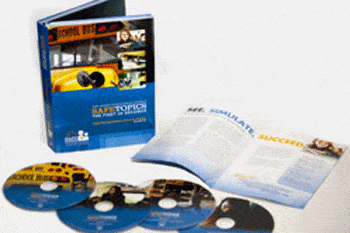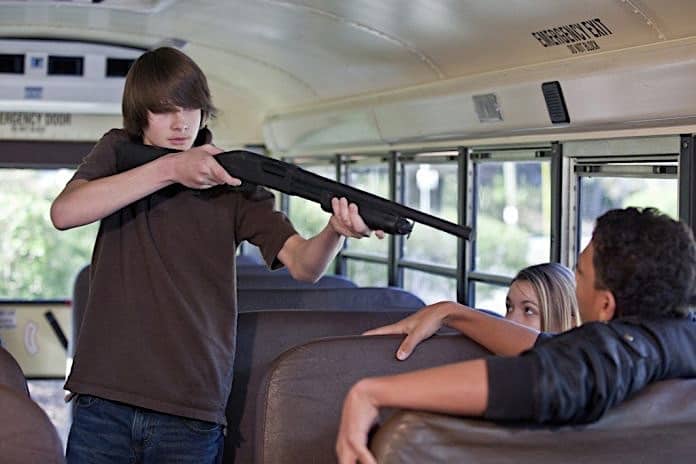A young boy gets on your school bus, carrying a guitar case. He seems more quiet than usual as you say, “Hi” to him as he boards. He puts his head down and walks down the aisle as if he knows what to expect. As he passes a group of students in the back of the bus they jostle him, one of them tousles his hair, and they laugh at him. He sits down, his head bowed for a second, when suddenly he stands up with a pump shotgun.
He jacks a round into the chamber, aims the shotgun at the one who tousled his hair and yells, “I am sick and tired of you messing with me!” If this happened on your bus, what would you do?
For transportation directors and supervisors everywhere, this is an important question leading to even more important questions. Is there a correct answer? If so, how can we train our drivers to be able to come up with the correct answer, and where do we find the time to conduct the training?
To be effective and to prevent liability issues, the training should be based on solid research on how the human mind actually works during a crisis.
Enter The First 30 Seconds
“The First 30 Seconds” is a DVD-based training program developed by Safe Havens International, the world’s leading non-profit school safety organization. The four DVD disc set contains an instructional disc, a documents disc, a scenario disc and an evaluation disc. My school district uses both the Pupil Transportation and School Staff sets. There also is a Special Needs Staff set.
 “The First 30 Seconds” is based upon the research of Dr. Gary Klein, as summarized in his book “Sources of Power: How People Make Decisions” (Klein, 1998) and expounded upon in another Klein book, “Naturalistic Decision-Making” (Klein, 2008). This research shows how various professions made decisions during a crisis — professions such as fire chiefs, fighter pilots, combat leaders, nurses in critical care units, and others.
“The First 30 Seconds” is based upon the research of Dr. Gary Klein, as summarized in his book “Sources of Power: How People Make Decisions” (Klein, 1998) and expounded upon in another Klein book, “Naturalistic Decision-Making” (Klein, 2008). This research shows how various professions made decisions during a crisis — professions such as fire chiefs, fighter pilots, combat leaders, nurses in critical care units, and others.
His research found that the brains of people under duress moves away from linear thinking, and actually uses a holistic approach called pattern-matching and recognition to arrive at a decision on a course of action. The subconscious will scan for an action in the past (pattern) that is similar to the present situation (matching), select one (recognition), and then will run a scenario to see if it will work (mental simulation).
Thus, decision-making in a crisis is not like a flowchart, but a scan-and-consider process that actually works more quickly, with better success. It is an intuitive process, not a deductive one. If you have ever experienced your “life passing before your eyes” phenomena, then you have experienced the conscious manifestation of the subconscious pattern-matching process.
How It Works
The key to teaching the Naturalistic Decision-Making Process is the development of a base of experience that a person will have available to be able to scan. This is done using short scenarios of less than a minute, and doing them on a regular basis.
The scenario at the beginning of this article is taken from “The First 30 Seconds.” You show the video clip, and then discuss with your drivers how they would respond. The Documents Disc contains discussion points for each scenario, as well as a worksheet for participants to take notes on what is discussed. Drivers are asked to engage in mental simulation whenever they can.
The discussion for each scenario can be as brief, or as long, as you want it to be. Therefore it can be incorporated into any meeting, or can be used as stand-alone training.
Evaluation and Success
As a director or supervisor, you will want to occasionally check your drivers to see if they are using mental simulation and learning what the need to learn. The Evaluation Disc contains scenarios to show an individual driver, and there are scoring sheets that you may use to assess a driver’s response. This isn’t done to punish a driver, but to identify areas in which they will need additional training.
Dr. Michael Roberto, author of “Know What You Don’t Know — How Great Leaders Prevent Problems Before They Happen”, wrote that cardiac units in the United Kingdom began training nurses with skills that before had only been provided to doctors. This training helped them spot the indications of a pending heart attack for high-risk patients in cardiac units.
These nurses became more effective in summoning rapid response teams, which would intervene to save the patient’s life, if necessary. These rapid response teams performed highly effective medical tests and procedures to help save the patient. Thus the additional training for nurses was extremely effective and quickly spread to hospitals around the world.
Medical professionals in Australia decided to add one minor adjustment when they implemented this concept. While relatively simple, it saved numerous lives. Aside from calling the rapid response team when they saw indicators of a pending heart attack, they were also told do so whenever a patient did not act in a similar manner to other patients with comparable medical conditions, based on the nurses’ experience.
Simply put, they were trained to look for behaviors that seemed odd, and then act on their gut feeling.
Of great importance was the fact that the nurses were told that they would not be penalized for false alarms. This gave the nurses the freedom to trust their own judgment and intuition. Errors become learning moments. This additional training, combined with the simple act of empowering the nurses to trust their instincts, reduced mortality in cardiac units by as much as 50 percent.
Now You Know
The use of “The First 30 Seconds” provides a powerful tool for directors and supervisors to increase the confidence of their drivers to handle whatever may happen in and around their buses. It is based on sound research, and has been proven in the field. Best of all, if your fleet does not have the funds to purchase the program, it can be replicated at no cost to you but your time. All you would need to do is create the scenarios and discussion points yourself.
How you use the program isn’t important, but using the program, or a similarly structured one, is.
Your drivers, and their precious passengers, are too important to do anything else.
***
Stephen Satterly is the director of transportation and school safety for the Community School Corporation of Southern Hancock County in New Palestine, Ind. He can be reached at ssatterly@newpal.k12.in.us.
















